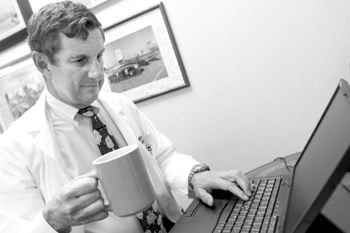
Dr. Drew Gaffney is leading the initiative for electronic safety reporting at Vanderbilt. (photo by Dana Johnson)
Workstations set up to report safety problems at VUMC
Beginning in late February in selected areas of the hospital and clinic, instead of using paper forms, staff and faculty will use clinical computer workstations to report safety problems. Electronic reporting will be one element in a more active practice of patient and visitor safety reporting throughout VUMC, said Dr. Drew Gaffney, professor of Medicine and Medical Administration and associate dean for Clinical Affairs.
The current paper reports are often too slow to make their way to Risk and Insurance Management, in some cases hindering the organization’s ability to respond quickly to safety issues. VUMC generates about 600 of the so-called risk management reports each month.
“The idea of using computers is to speed the process,” Gaffney said. “The person responsible for the area where the incident or problem occurred will get the report immediately. But we’re not looking at this as simply the computerization of an old process.”
Gaffney foresees a new approach to reporting. The necessity of reporting will feature more prominently in staff and faculty orientation and continuing education programs. Reports will be answered with individual feedback, including information about any assessments or changes that may occur as a result of a report.
“We’re asking everyone to look at their work environment with an eye to any potential errors,” Gaffney said. “We want people to see higher report frequency as a good thing, so that a manager can boast about having a high number of reports.”
“Often staff incorrectly feel they don’t need to report if the problem or mistake was caught before reaching the patient,” said Cindy Irwin, clinical risk manager. “And people are often afraid that reporting will reflect negatively on their work.” Irwin noted that risk management reports are unconnected with VUMC employee evaluation, and, although it makes feedback impossible and hinders additional information gathering, staff and faculty are always free to report anonymously (user log-on won’t be required).
Gaffney regrets that, instead of more actively observing and reporting problems, doctors tend to file risk management reports only after having become very upset. “Doctors are highly trained and skilled observers, and we want them to feel free to report, and in a sense obligated to report, when they observe a problem or potential problem.”
Risk management reports, also known as occurrence reports, are used to report any medical error, including medication errors; any near miss or potential error; patient falls and other injuries; tests performed on the wrong patient; discrepancy in supply counts following a surgical procedure; any equipment problems having safety implications; patient refusal of treatment; patients leaving against medical advice; any actual or potential injury to a visitor — in short, anything that has to do with the safety of patients and visitors or Vanderbilt’s exposure to liability. Under Tennessee law the reports are privileged and thus not subject to legal discovery, so they can’t be used in malpractice suits or other legal proceedings.
Training and pilot use of the electronic reporting system will begin in late February on 7 North/Cardiac Care Unit, Trauma, 5 North, the Cath Lab, the Pulmonary Clinic and the Dermatology Clinic. The user will work through menus and pick lists, with the information lodging automatically in a database. The appropriate patient care manager and risk management specialist will receive the report immediately. Managers can run a variety of aggregate reports, and the vendor supports safety/risk management benchmarking among some 80 client hospitals. The on-screen logo for the new reporting application will be VERITAS, for Vanderbilt Event Reporting and Incident Tracking Analysis System.













